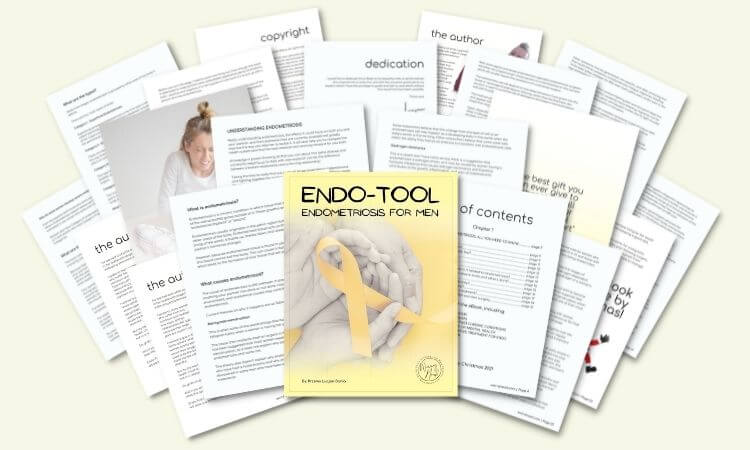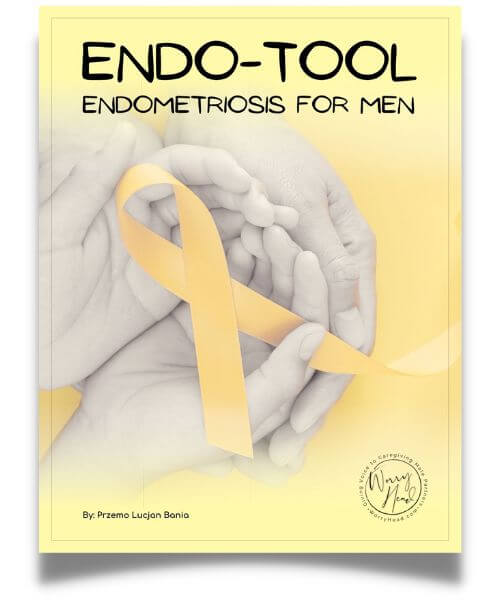
Endometriosis Basics
All You Need to Know
Every day I watch my wife fight a battle no one else can see, and I am reminded why this endometriosis basics page exists… If you are here because endometriosis keeps stealing your days, your plans, or your peace, you’re not alone.
I’m Lucjan, a husband who learned the hard way that love needs language, tools, and steady patience. This endometriosis basics guide is a clear, compassionate starting point – for women living with endo and for the partners who want to show up better. You’ll find plain-English explanations, gentle coping ideas for pain and fatigue, emotional support for the hard days, and practical ways a partner can help without overstepping.
This is the main guide that lays out the essentials in one place. It also links to deeper articles on symptoms, diagnosis, treatment options, pain and flare management, intimacy, mental health, nutrition, work/advocacy, and more, so you can find everything you need in detail…
And just to be clear – while I aim for medical accuracy and reference reputable sources – this is not medical advice! It’s a safe place to breathe, learn, and feel seen, written from a partner’s perspective, especially a man who loves someone living with endo.
- Endometriosis Basics
- What is Endometriosis?
- Prevalence of Endometriosis
- Symptoms of Endometriosis
- Causes & Theories for Endometriosis
- Diagnosis of Endometriosis
- Types of Endometriosis
- Treatment of Endometriosis
- Impact of Endometriosis
- Comorbidities of Endometriosis
- Fertility and Endometriosis
- Lifestyle & Diet with Endometriosis
- Awareness & Advocacy for Endometriosis
- Research & Future of Endometriosis
- Endometriosis Infographic
- My Wife's Endometriosis
- My Endometriosis eBook
Endometriosis Basics
Endometriosis changes more than cycles – it reshapes days, dreams, and how we love. If you’re new here, start with the basics: what exactly is endometriosis, and how does tissue that shouldn’t be there cause so much pain? How common is it – could 1 in 10 really mean people you know? What symptoms matter beyond “bad cramps,” and which red flags are easy to miss?
Why does it happen? We’ll explore the leading theories like retrograde flow, immune misfires, genetics, hormones, and why none of them is your fault. How is it diagnosed when scans look “normal,” and what makes laparoscopy the gold standard? Are there different types, and do they change treatment decisions?
What actually helps: medication, surgery, pelvic physio, nervous-system care? What about the everyday impact on work, intimacy, and mental health thatonly few clinics measure but you feel? If other conditions travel with endo, which ones should be on your radar?
Thinking about fertility: what are the real options, risks, and timing conversations? Which lifestyle shifts are worth your energy, and which aren’t? And finally, we’ll explore how can advocacy turn pain into policy, and what research on the horizon could shorten the road to relief – for you and your partner.
What is Endometriosis?
Endometriosis is a chronic condition where tissue similar to the lining of the uterus (endometrium) grows outside the womb. This causes pain, inflammation, and sometimes infertility.
Prevalence of Endometriosis:
- Affects 1 in 10 women worldwide (about 190 million globally).
- Often begins in reproductive years, but symptoms may persist after menopause.
Symptoms of Endometriosis:
- Severe period pain (dysmenorrhea).
- Pelvic pain outside of menstruation.
- Painful intercourse (dyspareunia).
- Fatigue and brain fog.
- Gastrointestinal symptoms (bloating, diarrhea, constipation – known as endo belly).
- Infertility (up to 50% of women with infertility may have endometriosis).
Causes & Theories for Endometriosis:
- Retrograde menstruation: menstrual blood flows back through the fallopian tubes into the pelvis.
- Immune dysfunction: the body cannot clear misplaced tissue.
- Genetics: higher risk if a close relative has it.
- Hormonal factors: estrogen-driven condition.
Diagnosis of Endometriosis:
- Average delay: 7–10 years.
- Misdiagnosed as IBS, ovarian cysts, or fibromyalgia.
- Imaging: ultrasound, MRI (helpful but not conclusive).
- Gold standard: laparoscopy (minimally invasive surgery).
Types of Endometriosis:
- Superficial peritoneal lesions (outer layer of pelvis/abdomen).
- Deep infiltrating endometriosis (penetrates organs like bowel, bladder).
- Ovarian endometriomas (“chocolate cysts”).
Treatment of Endometriosis:
- Medications: NSAIDs, hormonal therapy (birth control, progestins, GnRH agonists).
- Surgery: laparoscopic excision, sometimes hysterectomy (not a cure).
- Lifestyle approaches: diet, exercise, stress reduction, pelvic physiotherapy.
Impact of Endometriosis:
- Physical: chronic pain, fatigue, and infertility.
- Mental health: anxiety, depression, social isolation.
- Relationships: intimacy issues, strain on partners/marriages.
- Work/education: absenteeism, reduced productivity, job insecurity.
Comorbidities of Endometriosis:
- Adenomyosis (endometrial tissue within the uterine muscle).
- PCOS (Polycystic Ovary Syndrome).
- Fibromyalgia (chronic pain).
- Chronic fatigue syndrome.
Fertility and Endometriosis:
- Leading cause of female infertility.
- Increases risk of miscarriage.
- IVF success rates lower but possible.
Lifestyle & Diet with Endometriosis:
- Anti-inflammatory diet may reduce flare-ups.
- Foods to avoid: processed sugar, gluten, caffeine, alcohol.
- Helpful: omega-3, leafy greens, turmeric.
Awareness & Advocacy for Endometriosis:
- Endometriosis Awareness Month: March.
- Lack of funding and research compared to the prevalence.
- Celebrities raising awareness: Padma Lakshmi, Lena Dunham, Daisy Ridley.
Research & Future of Endometriosis:
- No cure currently.
- Ongoing research into genetics, immunology, and targeted therapies.
- Advocacy pushing for earlier diagnosis and better treatments.
If you’re standing beside someone you love through endometriosis, I have a gift for you: a FREE chapter of “Endo-Tool: Endometriosis for Men” eBook, a guide I wrote as a husband learning how to show up better.
Aside from that, when you subscribe, I’ll send more personal notes, checklists, and small wins we can use immediately, plus printable freebies, partner tips, and subscriber-only discounts on all my books. No spam. Just useful, compassionate support you can act on tonight.
The first chapter alone contains all the comprehensive medical knowledge about endometriosis, including:
- What is endometriosis?
- What are the symptoms?
- What causes endometriosis?
- What does endometriosis look like?
- What are the stages?
- What are the types?
- What is adenomyosis and how is it related to endometriosis?
- Why do some women develop severe endo and others don’t?
- Does endometriosis cause infertility?
- How is endometriosis diagnosed?
- Do types and stages affect the treatment?
- Recurrence of endometriosis after excision surgery.
FREE Chapter of “Endo-Tool”
Endometriosis e-Book for Men

What is Endometriosis?
Endometriosis is a chronic condition where tissue similar to the uterine lining (endometrium) grows outside the womb, on ovaries, pelvic walls, bowel, bladder, and occasionally beyond the pelvis. These implants respond to hormones, leading to inflammation, swelling, bleeding, and scar tissue (adhesions).
Pain may occur during periods and between them, with sex, bowel movements, or urination, and some face fertility challenges. Endometriosis isn’t “just bad cramps” but it is a whole-body, inflammatory pain chronic disorder that can affect energy, digestion, mood, work, and intimacy, requiring compassionate, long-term management from a multidisciplinary team.
Prevalence of Endometriosis
Roughly 1 in 10 women and people assigned female at birth live with endometriosis – an estimated 190 million worldwide. Symptoms often start in the teens or early twenties, but the condition can persist after menopause if lesions and adhesions remain.
Prevalence crosses all races, cultures, and income levels, yet access to diagnosis and specialist care is uneven. The scale is massive, and so is the silent burden carried by patients. Delays in recognition mean many go years without appropriate pain management or surgical assessment. Raising awareness among families, schools, and primary care can shorten that journey and spare years of avoidable pain.
Symptoms of Endometriosis
Symptoms vary widely but commonly include debilitating period pain (dysmenorrhea), pelvic pain outside of menstruation, painful intercourse (dyspareunia), and heavy or irregular bleeding.
Many experience fatigue, brain fog, nausea, bowel changes, bloating, diarrhea, and constipation, often called “endo belly.” Pain with bowel movements or urination during periods is frequent.
Symptoms of endo can flare unpredictably, disrupting work, study, and life. Severity doesn’t always match disease extent; mild lesions can cause severe pain, and others with advanced disease may feel little pain. Because patterns shift with hormones and stress, journaling symptoms, cycle timing, and triggers can reveal trends to discuss with clinicians and guide self-care.
Causes & Theories for Endometriosis
The exact cause remains unsettled. Leading theories include retrograde menstruation (cells flowing back through the tubes into the pelvis), immune dysfunction that fails to clear misplaced tissue, coelomic metaplasia (cells transforming into endometrial-like tissue), and genetic susceptibility.
Hormonal drivers – especially estrogen – modulate growth and inflammation, while environmental and microbiome factors may play roles.
Experts suspect multifactorial origins, which helps explain why symptoms, treatment response, and progression differ from person to person. Importantly, none of these theories blames patients; endometriosis is not caused by choices or pain tolerance. Understanding pathways can reduce shame and help personalize treatment.
Diagnosis of Endometriosis
Diagnosis is often slow. On average, 7–10 years from first symptoms because signs overlap with IBS, ovarian cysts, pelvic floor dysfunction, and even fibromyalgia. Pelvic ultrasound and MRI can suggest disease (e.g., endometriomas or deep lesions), yet imaging may be normal.
The surgical gold standard is laparoscopy, which allows direct visualization and biopsy, often paired with excision. A detailed history, cycle tracking, and a clinician who listens are crucial, and shared decision-making helps weigh watchful waiting, medication, or surgical evaluation. Validating pain early matters. Education for clinicians and patients can close the gap, helping people reach specialist teams sooner and avoid years of trial-and-error with inadequate relief.
Types of Endometriosis
Clinicians often describe three overlapping patterns. Superficial peritoneal disease involves lesions on the pelvic lining. Deep infiltrating endometriosis penetrates organs such as bowel, bladder, uterosacral ligaments, and the vaginal wall, often driving severe pain and dysfunction. Ovarian endometriomas – “chocolate cysts” – are blood-filled cysts that can damage ovarian tissue and fertility.
Adhesions can tether organs and intensify pain. Classifications guide planning, but symptoms don’t always mirror stage; individualized assessment remains essential. Knowing the pattern helps set expectations for imaging, surgery, recovery, and long-term management and it can make conversations with partners and employers more concrete and supportive.
Treatment of Endometriosis
With the treatment of endometriosis, care is individualized. Medications include NSAIDs for pain and hormonal options that suppress or modulate estrogen or combined pills, progestins, LNG-IUDs, GnRH analogues/antagonists, and newer agents. Surgery, ideally expert laparoscopic excision, can remove lesions and release adhesions; hysterectomy may help co-existing adenomyosis, but it isn’t an endo cure.
Multidisciplinary support matters. Pelvic physiotherapy, pain-science education, mental-health care, sleep and stress strategies, gentle movement, nutrition, and pacing. Most patients need blended approaches over time. Plans evolve across life stages, study or career, intimacy, fertility goals, pregnancy, and perimenopause. A coordinated team helps align care with what matters most to you.
Impact of Endometriosis
Endometriosis can touch every corner of life. Physically, there’s chronic pain, flares, nausea, fatigue, and sometimes infertility. Mentally, many face anxiety, depression, and the trauma of dismissal.
Relationships may strain under invisible pain, guilt, or fear of intimacy. Work and education suffer through absenteeism, presenteeism, and stalled careers, while financial costs accumulate from medications, travel, and time off. None of this reflects weakness; it reflects a serious disease that deserves validation, accommodation, and effective care.
Community, online or local, can buffer isolation, offer practical hacks, and remind you that nothing about this journey is your fault.
Comorbidities of Endometriosis
Endometriosis may coexist with many conditions, such as adenomyosis (endometrial tissue within the uterine muscle), PCOS, pelvic floor dysfunction, interstitial cystitis/painful bladder syndrome, IBS, migraines, autoimmune features, fibromyalgia, and CFS (chronic fatigue syndrome). Overlap can muddy diagnosis and magnify pain, fatigue, and sensory sensitivity.
A multidisciplinary lens, such as gynecology, gastroenterology, urology, pelvic physio, pain medicine, and mental health, helps untangle symptoms and avoid tunnel vision. Tracking patterns and triggers supports more precise, compassionate care. Gentle curiosity, rather than blame, around overlapping conditions can prevent unnecessary shame and lead to integrated plans that treat the person, not just the pelvis.
Fertility and Endometriosis
Endometriosis is a leading cause of infertility, affecting ovulation, egg quality, tubal function, implantation, and pelvic anatomy via adhesions. Sadly, my wife couldn’t have children because of her stage IV endo, but some women conceive naturally, other women need time-to-pregnancy support, surgery, ovulation induction, IUI, or IVF.
Outcomes vary by age, ovarian reserve, disease type, and clinic expertise. Miscarriage risk may be higher, yet many achieve healthy pregnancies with tailored care. Fertility choices are deeply personal, so seek balanced counseling that respects goals, timelines, and emotional wellbeing. Psychological support is as vital as procedures because of grief, hope, and uncertainty that often coexists, so having space for each emotion is part of good care, whatever path you choose.
Lifestyle & Diet with Endometriosis
Lifestyle changes can’t cure endo, but they may reduce symptom burden. Many find benefit in anti-inflammatory patterns such as colorful vegetables, omega-3s, adequate protein, and spices like turmeric; limiting ultra-processed foods, excess sugar, caffeine, and alcohol may help.
Gentle movement, pelvic physiotherapy, heat, sleep routines, and stress regulation (breathwork, CBT, pacing) support nervous-system calm. Track what helps because bodies differ. Any plan should be practical, sustainable, and paired with medical care when needed. Beware rigid rules or one-size-fits-all plans; flexibility protects mental health. Partner support with shopping, cooking, and pacing can make sustainable change possible.
Awareness & Advocacy for Endometriosis
March is Endometriosis Awareness Month, but advocacy is needed year-round. Underfunding, stigma, and long diagnostic delays persist despite high prevalence. Sharing stories, educating workplaces and schools, and supporting research charities can change trajectories. Public figures like Padma Lakshmi, Lena Dunham, and Daisy Ridley have amplified visibility, but the most powerful voice may be yours (or hers).
Partners (like me) can help by documenting symptoms, attending appointments, and advocating for compassionate, evidence-based care. Your story, data, and persistence can reshape policies – from period pain education to workplace adjustments – so fewer people are told to “tough it out.”
Research & Future of Endometriosis
There’s no cure yet, but momentum is building. Research spans genetics and epigenetics, immune and inflammatory pathways, stem-like cells in lesions, pain mechanisms, and both hormonal and non-hormonal therapies. Advances in imaging, biomarkers, and surgical technique aim to speed diagnosis and personalize care.
Patient-led advocacy pushes for earlier recognition, clinician training, and equitable access worldwide. Hope here isn’t naïve. It is a plan for better science, better systems, and better lives. With sustained funding and patient leadership, the field is moving toward earlier diagnosis, less invasive options, and treatments that target endo pain pathways without sacrificing quality of life.
Endometriosis Infographic
(FREE for You to Download Below)

My Wife’s Endometriosis
As a man who loves a woman with endometriosis, I have seen firsthand the challenges that come with this chronic condition.
Endometriosis can cause pain that ranges from dull discomfort to debilitating cramps, making it difficult for my wife to perform even the simplest of tasks. The pain can occur at any time, but it’s often most intense during her menstrual cycle, which can last for days or even weeks.
But it’s not just the physical pain that takes its toll.
Endometriosis can also cause emotional distress, leaving my partner feeling frustrated, helpless, and isolated. The condition can impact her fertility, which can add another layer of stress and anxiety to our lives.
Despite all these challenges, my wife remains incredibly strong and resilient. She faces each day with grace and determination, never letting endometriosis define her or limit her abilities. As her husband, I feel a deep sense of pride and admiration for her strength and courage.
While there is no cure for endometriosis, there are treatments available to manage the symptoms. I do everything I can to support my wife through this journey. I attend doctor’s appointments with her, help manage her pain with medications or heat therapy, and always listen to her when she needs to talk.
Most importantly, I remind my wife that she is not alone in this battle. I am here with her every step of the way, no matter what the future holds. Together, we can face the challenges of endometriosis and emerge stronger and more united than ever before.
My Endometriosis eBook
Have you ever felt helpless and lost when your partner experiences excruciating pain during their menstrual cycle? Have you ever wished you could do more to support them?
As someone who loves and cares for their partner, you understand the importance of being there for them during tough times. But when it comes to endometriosis, it can be challenging to know how to help.
That’s where our endometriosis eBook comes in. Written specifically for men, this guide is the missing piece you need to understand what your partner is going through and how to be the best support possible.
Endometriosis is a condition that affects millions of women around the world, causing pain, discomfort, and emotional distress. And while it may seem like something that only affects women, it impacts their partners, too.
Our eBook is designed to help you navigate the challenges of endometriosis and learn how to be a supportive partner. From understanding the condition to learning practical ways to help manage symptoms, we’ve got you covered.
But this eBook isn’t just a practical guide. It’s a heartfelt, emotional journey that will help you connect with your partner on a deeper level. By understanding what they’re going through and being there for them, you’ll strengthen your relationship and build a stronger foundation for the future.
So if you’re ready to be the best partner possible and support your loved one through their endometriosis journey, our eBook is the resource you need. With clear, concise information and heartfelt insights, it’s the perfect guide to help you understand and navigate this difficult condition.
Order your copy today and take the first step towards being the partner your loved one needs and deserves.

“Endo-Tool: Emetriosis for Men”
Endometriosis is a chronic condition that can cause pain and affect many areas of a woman’s life. If you are the partner of a woman who suffers from endometriosis, you know how challenging it can be to balance her care with your relationship.
I have created an eBook that was designed specifically for male partners of women who suffer from endometriosis. Endo-Tool gives a lot of medical information about the illness, but also how to navigate through the challenges endometriosis brings to your relationship.
The book reveals how to support your partner in the process of her diagnosis, treatment, and management of endometriosis.


About Me
Hi, I’m Lucjan! The reason why I decided to create this blog was my beautiful wife, who experienced a lot of pain in life, but also the lack of information about endometriosis and fibromyalgia for men…
READ MORE